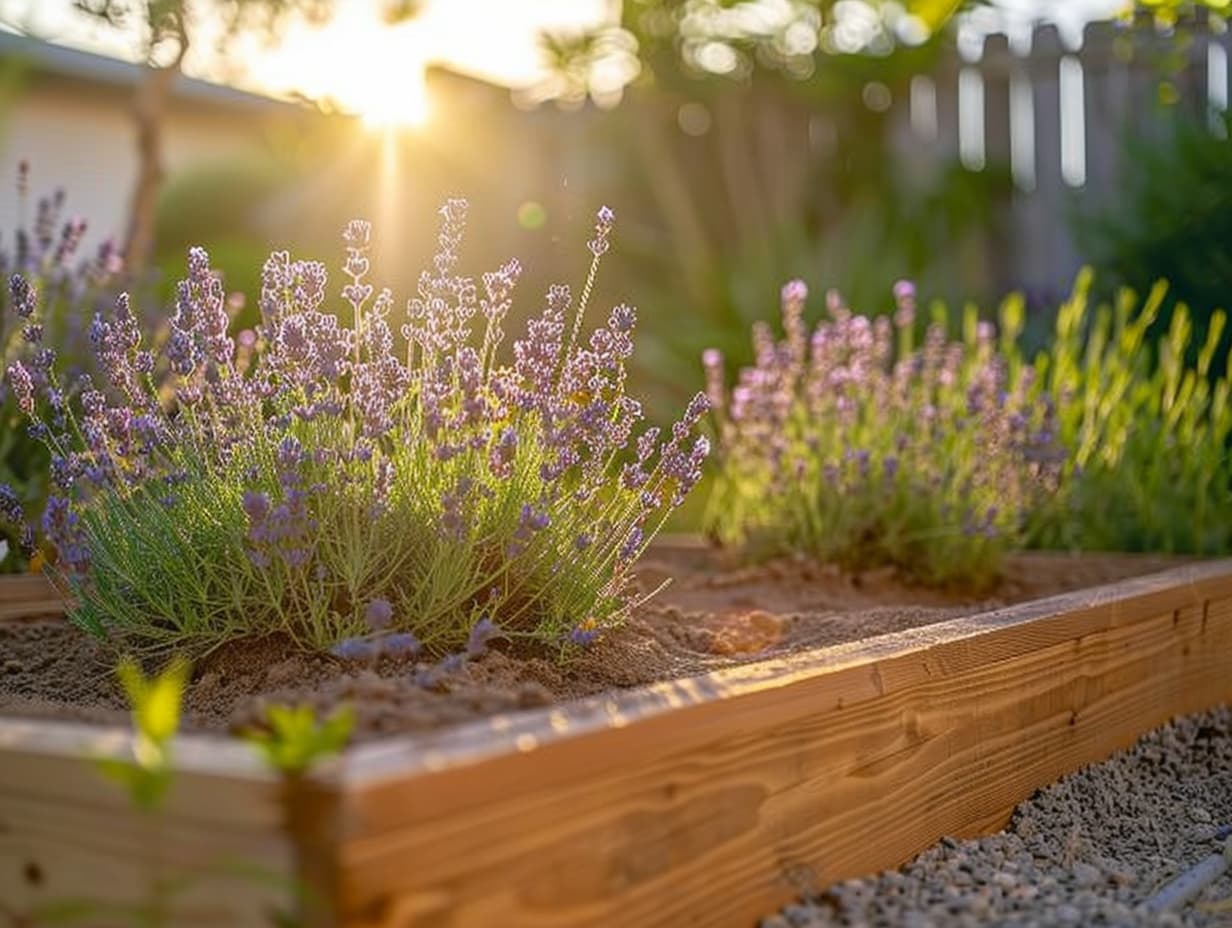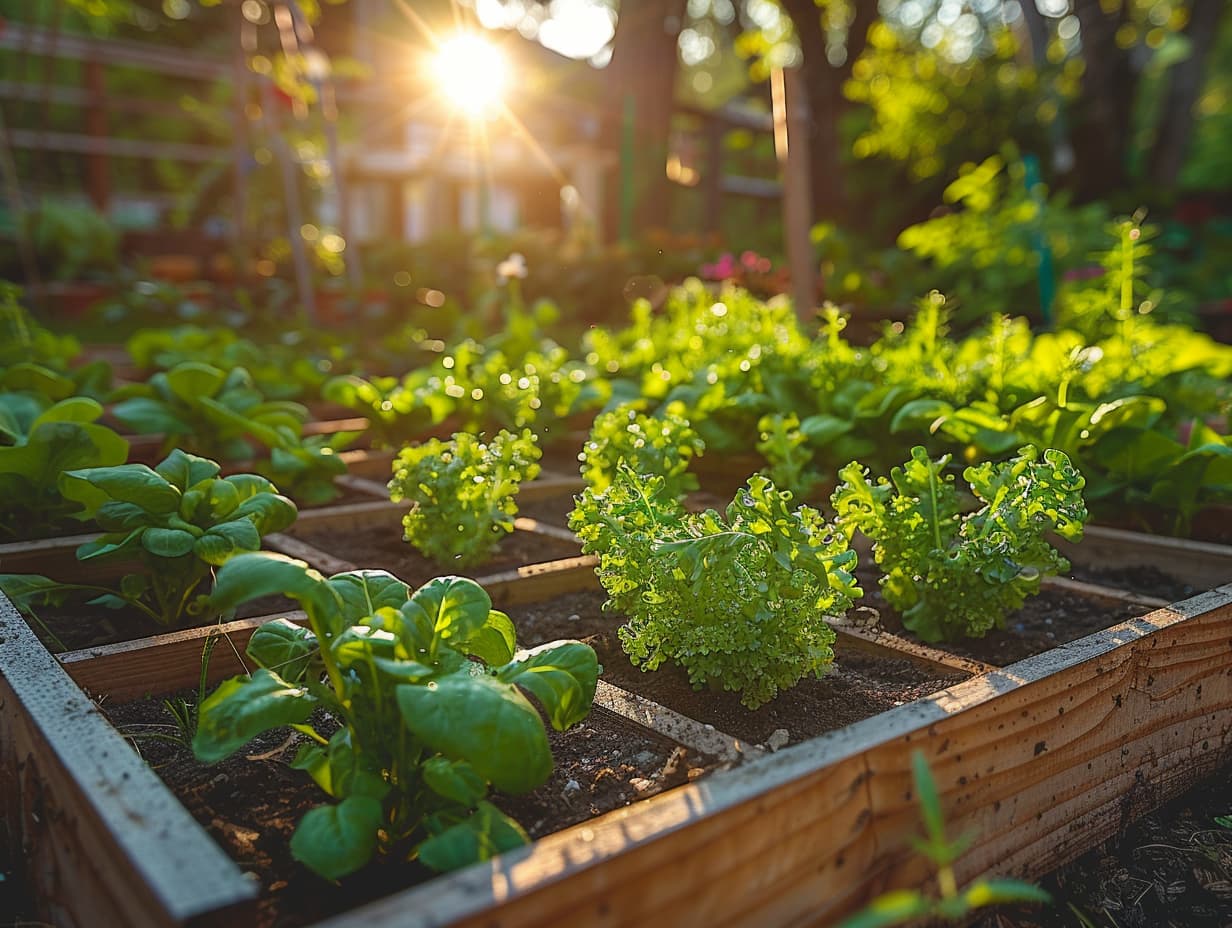When you buy products via links on our website, we might receive an affiliate commission. Learn more
18 Raised Garden Bed Ideas for Your Backyard

Transform your backyard with these 18 creative raised garden bed ideas! Construct durable beds from cedar wood, known for its resistance to rot and natural beauty.
Use corrugated metal sheets for a modern, industrial look, or build geometrically pleasing triangular beds to maximize gardening areas. Dedicate sections to pollinator-friendly flowers to enhance your garden's ecosystem, or use eco-friendly materials like upcycled wooden pallets.
Design spiraling herb gardens, multi-level beds for varied sunlight, or mix edibles with ornamentals for functional beauty. Illuminate with fairy lights for evening charm, or grow essentials in a window box. Embrace square foot gardening to optimize your space and yield!
Start your garden project today and enjoy a vibrant, flourishing backyard that reflects your personal style and meets your culinary needs.
Construct Raised Garden Beds From Cedar Wood

Cedar is highly resistant to rot, decay, and insect attacks, making it an ideal material for outdoor use. Its rich, warm tones enhance the aesthetic appeal of your garden, while the natural oils in the wood emit a pleasant scent.
Additionally, cedar is lightweight, making it easy to work with during the construction process.
These beds can be designed in various shapes and sizes to fit specific gardening needs, providing a functional and visually appealing framework for planting a variety of flowers, vegetables, and herbs.
Use Corrugated Metal Sheets to Create Raised Garden Beds

Using corrugated metal sheets to create raised garden beds provides a contemporary and industrial look that’s perfect for modern landscaping.
These metal beds are not only stylish but also highly durable, resistant to weather, and easy to maintain.
The corrugated design adds structural strength and ensures longevity. Metal conducts heat, warming the soil in early spring and extending the growing season. You can customize the height and shape of these beds to suit your garden layout and accessibility needs.
Additionally, painting the metal can add a pop of color or help it blend seamlessly with your garden’s overall design, enhancing both functionality and visual appeal.
Build a Triangular Raised Garden Bed

This geometric design not only maximizes gardening area but also adds a modern aesthetic to the landscape. Constructing the bed with sides equal in length allows for easy access to all plants, facilitating maintenance and harvesting.
You can use a variety of materials such as wood, stone, or metal to match your garden’s style.
Additionally, the triangular shape creates opportunities for creative planting schemes, such as organizing plants by height or color gradient, enhancing both the functionality and visual interest of your garden space.
Dedicate a Raised Garden Bed to Pollinator-Friendly Flowers

Select a variety of plants that bloom at different times of the year to provide a continuous food source for bees, butterflies, and other pollinators.
Include flowers like lavender, sunflowers, zinnias, and wildflower mixes known for their nectar and pollen.
Planting in a raised bed allows for better control over soil conditions, ensuring that your pollinator plants thrive. This not only aids the pollinators but also enhances the health and productivity of your garden by improving pollination rates for all plants.
Design Permanent Raised Garden Beds Using Stones

Stone beds provide excellent durability and can withstand various weather conditions, making them a lasting investment.
The natural texture and color variations of stone add an elegant, rustic charm that complements both traditional and contemporary landscapes.
Stones can be stacked in dry-stack fashion or secured with mortar for additional stability. The thermal mass of stone also helps regulate soil temperature, promoting a healthier growing environment for plants.
By shaping the stones to fit your specific design needs, you can create unique, curved, or angular beds that blend seamlessly into your garden’s overall aesthetic.
Upcycle Wooden Pallets to Create Eco-Friendly Raised Garden Beds

Wooden pallets, often available for free from local businesses, can be transformed into attractive, functional garden beds with minimal effort.
To ensure safety, choose pallets that are heat-treated (marked with "HT") rather than chemically treated.
Sanding and applying a non-toxic sealant can further protect the wood and extend the life of your beds. Pallets can be left whole for deeper beds or dismantled for custom configurations.
This approach not only recycles material but also adds a rustic charm to your garden, making it both green and stylish.
Design Circular Raised Garden Beds

Circular beds are especially effective as focal points in the middle of a garden or at the end of pathways. These beds allow easy access from all sides, making planting, maintenance, and harvesting more convenient.
You can construct these beds using a variety of materials such as bricks, stones, or curved metal edging to complement the aesthetic of your garden.
The shape encourages natural plant growth patterns and can be used to create interesting planting designs, such as concentric circles of different flowers or herbs, enhancing both the utility and beauty of your garden.
Build Garden Beds Made From Sturdy Concrete Blocks

Concrete blocks are readily available and relatively inexpensive, making them an excellent choice for constructing raised beds. Their modular nature allows for easy customization in terms of layout and size, accommodating gardens of all shapes and sizes.
Additionally, the hollow centers of the blocks can be used as planters for herbs or flowers, maximizing space and adding an aesthetic appeal.
Painting or decorating the blocks can also enhance their appearance, blending them into the garden landscape or allowing them to stand out as a feature.
Design a Spiral-Shaped Raised Garden Bed to Grow Herbs

This unique shape maximizes growing space and can fit into surprisingly small areas, making it ideal for both large gardens and compact urban spaces.
Constructing the spiral with a gradual incline allows for excellent drainage and creates varied microclimates within the same structure.
Herbs that prefer drier conditions, like rosemary and thyme, can be planted at the top, while those requiring more moisture, such as basil and cilantro, can thrive at the bottom.
Cover a Raised Garden Bed With a Clear Plastic Canopy to Create a Mini Greenhouse

Covering a raised garden bed with a clear plastic canopy to create a mini greenhouse is an effective way to extend the growing season and protect sensitive plants from adverse weather conditions.
This setup allows sunlight to reach the plants while trapping heat and moisture inside, creating a warm and humid microclimate ideal for germination and growth.
Use durable, UV-resistant plastic to ensure longevity and prevent damage from sun exposure.
Create Multi-Level Raised Garden Beds for Different Sunlight Needs

Creating multi-level raised garden beds tailored for different sunlight needs is an innovative way to utilize space effectively while catering to the diverse requirements of various plants.
This tiered structure allows you to place sun-loving plants on the upper levels where they can receive ample light, while shade-tolerant species can thrive on the lower tiers, shielded from intense sunlight.
Constructing these beds using materials like wood or metal frames adds to the visual appeal and durability. The design not only maximizes planting area but also facilitates easy access for maintenance and harvesting.
Mix Edibles With Ornamentals in the Raised Garden Bed for Beauty

Mixing edibles with ornamentals in a raised garden bed combines beauty and utility, creating a visually appealing and productive garden space. This approach encourages biodiversity, which can help reduce pests and diseases naturally.
Start by choosing vegetables that have decorative features, such as purple kale, rainbow chard, or red-leaf lettuce, and blend them with flowering plants like marigolds, nasturtiums, or lavender that can attract pollinators and deter pests.
Design Raised Garden Beds With Woven Willow

Willow is flexible and strong, making it ideal for creating curved or circular designs that can adapt to various garden layouts. To construct these beds, secure upright willow rods into the ground and weave thinner branches between them to form the walls.
This natural material blends seamlessly into outdoor environments and provides a breathable, yet sturdy structure that enhances soil temperature regulation and drainage.
The organic texture and aesthetic of woven willow encourage a tranquil, cottage-style garden atmosphere, while also being eco-friendly and fully biodegradable.
Grow Chamomile and Lavender on Raised Garden Beds for Medicinal Purpose

Start by selecting a sunny spot as both chamomile and lavender thrive in full sun. Prepare the soil with plenty of organic matter to ensure it is loose and fertile.
Plant lavender at a higher spot within the bed because it needs very good drainage, while chamomile can be more flexible in placement.
Both plants are not only useful for their calming and healing properties but also attract pollinators, enhancing the biodiversity of your garden.
Illuminate Raised Garden Beds With Fairy Lights

To install, weave the lights around the edges of the raised beds or drape them above the plants using stakes or poles. Choose LED fairy lights for their energy efficiency and durability.
Choose solar-powered options if electrical outlets are not conveniently accessible, ensuring the lights charge during the day and illuminate automatically at night.
This lighting not only enhances the visual appeal of your garden but also allows you to enjoy its beauty during evening hours, creating a cozy and inviting outdoor living space.
Use the Raised Garden Beds to Grow Your Own Food

Using raised garden beds to grow your own food enhances soil conditions, improves drainage, and facilitates easier access for tending crops. These beds enable the creation of an ideal soil mix, fostering optimal plant growth.
Organize your garden by planting vegetables with similar needs together, such as tomatoes, peppers, and herbs, which thrive under similar conditions. Raised beds minimize bending and reaching, making gardening more comfortable.
This approach not only yields fresh, organic produce but also promotes sustainable living by reducing your carbon footprint and allowing control over your food's cultivation, free from unwanted chemicals.
Grow a Raised Garden in a Window Box

Growing a raised garden in a window box is a fantastic option for those with limited space. Choose a window box that fits your window sill and ensure it has good drainage.
Fill it with a quality potting mix, ideal for container plants. Select plants based on the sunlight available; herbs like basil and chives, or flowers such as marigolds and pansies, are suitable choices.
Regularly water and fertilize, as container plants tend to dry out and exhaust nutrients more quickly.
Leverage Raised Garden Beds for Square Foot Gardening

Leveraging raised garden beds for square foot gardening maximizes your growing space, making it highly efficient and manageable.
This method involves dividing the garden into small square sections, typically 1x1 foot each, to optimize space and facilitate easier planting, maintenance, and harvesting.
Start by constructing a raised bed, ideally 4 feet wide by any length, allowing easy access to each square without stepping into the bed.
Fill it with a rich soil mixture conducive to intensive planting. Assign each square a specific number of plants based on their size at maturity, ensuring they have ample room to thrive without overcrowding.
This systematic approach not only enhances yield per square foot but also reduces weeding and water wastage, making it perfect for urban gardeners or those with limited outdoor space.
